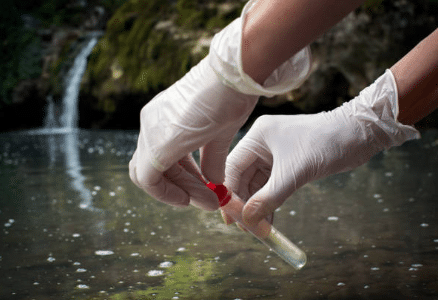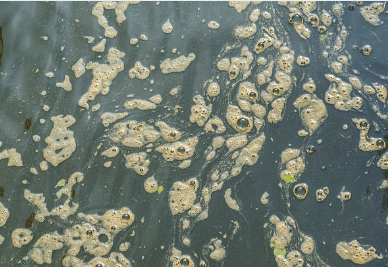Water Sediment
What is water sediment?
Water sediment refers to solid particulate matter suspended or deposited at the bottom of a water body.
What is its source?
It includes sediments from the natural environment and human activities. Water sediments in the natural environment mainly come from soil erosion, rock fragmentation, and biological activities, while water sediments produced by human activities include sewage discharge, industrial wastewater, agricultural activities, and building construction.

The effect of water sediment
Water sediments have various effects on water bodies and ecosystems, the following are the effects of water sediments on various aspects:
- Increased water turbidity: solid particles in water sediments will make the water turbid and reduce the transparency and clarity of the water. Turbid water is not only aesthetically pleasing, it can also affect water usage and disposal.
- Deterioration of water quality: There may be organic matter, heavy metals, nutrients and other pollutants in the water sediment. These pollutants can negatively affect water bodies, disrupt water quality balance, and lead to problems such as eutrophication, algal blooms, and corruption.
- Damage to the aquatic ecosystem: The accumulation and settlement of water sediments will change the bottom structure and ecological environment of the water body, affecting the habitat and breeding conditions of aquatic organisms. Excessive sediment can lead to insufficient oxygen supply in the water, affecting the survival and reproduction of aquatic organisms.
- Limited utilization of water resources: Excessive water sediments may lead to siltation of water bodies and blockage of river channels, affecting the utilization of water resources. Silted river courses can result in blocked water flow, increasing flood risk and reducing usable water body capacity.
- Difficulty in water treatment: Water deposits can cause problems in the water treatment process. They can cling to pipes, equipment and filter media, blocking water flow and filtration processes, reducing the efficiency of water treatment equipment and increasing cleaning and maintenance costs.

Water sediment is that it will affect the biodiversity and ecological balance of the water ecosystem, and affect the habitat and living conditions of aquatic organisms. This is why water quality is an important factor, and removing water sediment is also the most critical step.
How to remove water deposits?
- Screen filtration: Use screens or filters with different pore sizes to trap solid particles and sediment in the water. This method is suitable for sediments with larger particles, such as sediment, suspended matter, etc.
- Sedimentation and Settling: Allow the sediment to settle or settle to the bottom naturally by allowing the water to stand or slowing down the flow. This usually requires the use of equipment such as settling ponds, settling tanks or settling ponds.
- Stirring and suspension: by stirring the water body or injecting a suspending agent, the sediment is suspended in the water, and then the suspended sediment is removed by filtration or other methods. This method is suitable for sediments with smaller particles, such as fine particle suspensions.
- Chemical treatment: Use chemicals to treat water sediments, such as adding flocculants or precipitants, to promote sediments to condense into larger particles for easy removal. Chemical treatments are often used to treat fine-grained deposits.
- Hydraulic cleaning: use high-pressure water flow or jet water to wash and clean the sediment on the surface of the water body and inside the pipeline. This method is often used to remove buildup from pipes, equipment and surfaces.
- Physical removal: Physical removal of sediment from water bodies or equipment surfaces using mechanical equipment such as scrapers, brushes, vacuum cleaners, etc.
Water Quality Parameters Containing Water Sediments
There are more impurities in the water with water sediment, we can use the brand Apure professional instrumentation equipment to measure the water quality parameters with water sediment.
| Water Quality Parameters | Describe |
| Turbidity(NTU) | Reflect the concentration and size of suspended solids in water |
| Total Suspended Solids (TSS) in Water | The mass concentration of total suspended solids in water |
| Suspended Matter (mg/L) | Indicates the total mass of suspended solids in water |
| Sediment Chemical Composition | Composition of sediments including organic matter, inorganic salts, heavy metals, etc. |
| Dissolved Oxygen (DO) | The concentration of dissolved oxygen in water |
| Chemical Oxygen Demand (COD) | The amount of chemical oxygen required to oxidize organic matter in water |
| Biochemical Oxygen Demand (BOD) | The amount of oxygen consumed by microorganisms to break down organic matter |
| PH Value | A measure of acidity and alkalinity in water |
| Conductivity | The ability to measure the conduction current in water, which can indirectly reflect the dissolved solids in water |
| Ammonia | Nitrogen concentration of dissolved ammonia and ammonia salts in water |
| Nitrite (NO2-N) | Concentration of nitrite ions in water |
| Nitrate (NO3-N) | Concentration of nitrate ions in water |
| Phosphate (PO4-P) | Concentration of phosphate ions in water |
How To Monitor The Water Quality Of Water With Water Sediment?
Instruments are usually used to detect water quality in water. The main instruments and functions are listed below:
- Total suspended solids meter: Measure the concentration and turbidity of suspended solids in water, used to evaluate the clarity and turbidity of water bodies. Apure S-730 MLSS TSS Total Suspended Solids Meter.
- Sedimentation turbidity meter: Provides information on the sedimentation rate of suspended solids and sediment concentration in a water body by measuring the concentration and turbidity of settled solids in water.
- Settling tube: used to collect water samples, observe the sedimentation rate and particle distribution of the sediment within a certain period of time, and evaluate the sediment content in the water body.
- Particle counter: Measure the number and particle size distribution of suspended particles in water, used to evaluate the particle content and particle size in water.
- Sediment sampler: used to collect sediment samples in water bodies for subsequent analysis and assessment of the nature and composition of the sediment.
- Water quality multi-parameter instrument: including PH meter, dissolved oxygen meter, turbidity meter, etc., which can monitor multiple parameters of water body, including turbidity and suspended solid content.
In addition to the instruments and meters mentioned above, water quality monitoring involves a wide range of fields, and different application sites need to water monitor different parameters.
Summary:
Water sediments have multiple impacts on water quality and ecosystems. Apure’s water quality analysis instruments can monitor the sediment in the water, which helps to assess the water quality status and take appropriate treatment measures. With more than 16 years of experience in the instrumentation, Apure has grown to be a leading manufacturer of instrumentation in China and provides ONE-STOP service to global clients. If in doubt, please feel free to contact Apure professional technicians.
Extended reading:
What is ORP?
What is salinity meter and how does it work?
What Is Municipal Water?
Surface Water vs Groundwater
